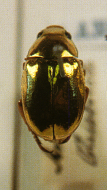Spooky Spiders
- ldougan38
- Oct 3, 2022
- 2 min read
Updated: Oct 11, 2022
Create your own spooky spider and learn about thermochromic materials


Thermochromic liquid crystals.
Liquid crystals are fluids in which long, thin molecules are organised so that they point in a particular direction. Some of these molecules have a property known as chirality or handedness and this means that they can organise themselves to form a spiral structure. This kind of liquid crystal is often known as cholesteric because it was first made from chemicals related to cholesterol.

The image on the left shows long, thin molecules organised in a liquid crystal phase. Notice that the molecules (red) are pointing towards the same direction, a bit like grains of rice in a shallow dish.
If the molecules are chiral, they can form a spiral structure. The repeat distance is often similar to the wavelength of light, so interference colours can be seen. These are bright, iridescent colours seen in thermometers and even some beetles.
The spiral twists and untwists as the temperature changes, causing a change in colour – this effect is thermochromic and it has been used in thermometers, some paints, jewellery such as mood rings and even nail varnish https://www.youtube.com/watch?v=6yyrla2gpwk
Liquid crystals respond to a voltage as well as responding to temperature, an effect well-known in LCDs (liquid crystal displays). Cholesteric liquid crystals are used in Boogie Boards https://myboogieboard.com, writing causes the spirals to orient so you see the colours and a voltage erases the board.
At Leeds, we research into many kinds of liquid crystals and we are responsible for developing an understanding of the optical properties of cholesteric liquid crystals. You can find out a bit more about all of the different kinds of liquid crystals at https://en.wikipedia.org/wiki/Liquid_crystal
The Spooky Spider Maker Kit is a collaborative project by Devesh Mistry, Helen Gleeson, Erin McNeill, Andy Guy and Lorna Dougan at the University of Leeds.
We acknowledge funding from the Engineering and Physical Sciences Research Council (EPSRC), Royal Academy Engineering (RAE) and Economic and Social Research Council (ESRC).













Comments